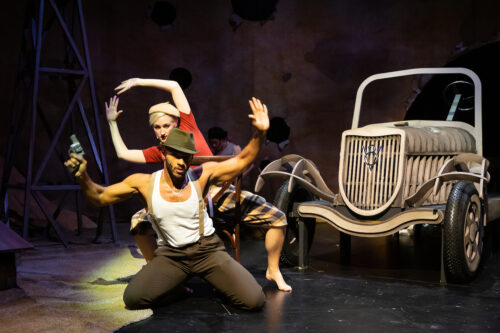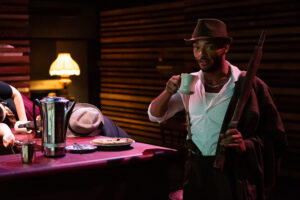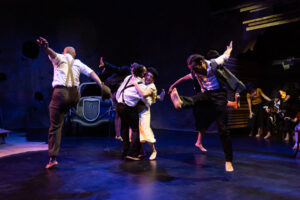Take a Ride with Open Dance Project’s Bonnie & Clyde

Photo by Lynn Lane
Take a Ride with Open Dance Project’s Bonnie & Clyde
Moody Center for the Arts, Rice University, May 27-June 4
I’ll state up front that if anyone else in Houston was putting on a dance theater production about Bonnie and Clyde, I doubt that I would have given it a second glance. My interest in gangsters, however romanticized by Hollywood, is pretty low.
That it was a production by Annie Arnoult and Open Dance Project made it worth a look. ODP has made a reputation for themselves as innovators by staging dance with their immersive approach. Standouts in my memory are Panopticon (2019) and Dada Gert (2018), the latter being the piece that made me an ODP follower.
So I entered the world of Bonnie & Clyde with low interest in the subject matter but high expectation for the presentation.
For anyone who has not experienced an immersive dance production, let me explain that concept. The stage and the audience occupy the same space. The dancers and audience must navigate each other within the space, creating the slightest hint of improvisation for the dancers and allowing the audience to be within inches of the performers. (Indeed, the night I saw B&C, I misjudged a movement and got lightly tapped by a chair being carried by a dancer.) It’s an adventure for all involved.

Photo by Lynn Lane
The world I stepped into at the Moody Center was one of right-angled corners and shadows. Walls of slatted wood allow for watching from one “room” into another, a tactic I employed more than once during the performance’s hour. The area one first enters is a bar with a sign, “Marco’s Café.” The dancers are strewn about the floor, the apparent aftermath of a gunfight. On the small tables of the café are open suitcases, filled with cash, road maps, empty shotgun shells, and toy trucks. Newspapers lay open on other tables. Adjacent to the café is a small room with a wooden bench or bed (according to narrative needs) and another small table with a typewriter. Around the other side of the café is a hallway with more tables and newspaper clippings tacked to the slatted wall.
Once you step around and over the dancers and enter the largest open area, you’re in a composite space with a bank vault door, an old automobile, and a rooftop of a building that is mostly hidden below floor-level, recalling photos of buried buildings from the 1930s dustbowl. It’s an environment created by scenic designer Ryan McGettigan that is worth exploring as its own installation.

Photo by Lynn Lane
Once the dancers begin to stir, we are treated to movement that tells the story of the titular gangsters, alternatively tender and violent, fun-loving and sensual. Projections on the wall and voice over narration give context. The Americana-style music is presented both live and via recordings. Different dancers appear to take on the main actors in the drama, perhaps emphasizing how we can see other violence from the last century reflected in this story. A recurring movement that helps set the themes is the familiar hands up (don’t shoot) posture followed by a side-bend, as though avoiding the shots that come anyway. Chairs and tables are rearranged. Dice are thrown on the floor. Typewriter, rooftop. and car are employed inventively, creating mood as well as location.
Seeing this production, as I did, the day after the Uvalde shooting, I want to mention two aspects that I deeply appreciated. First, the prop guns are clearly not real. They are creatively designed and carved from wood and work quite well for the show while also letting us see, particularly from our up-close proximity, that they are solid and incapable of shooting bullets. This allowed me to experience the danger implied by being in the line of “fire” now and then without actually feeling in danger. Second, sound effects for the gunshots, while clearly intended to represent gunshots, were not overly realistic. I was bracing myself for that sound and was relieved that I was allowed to experience the narrative without questioning reality. That made its incorporation into the music towards the end more palatable, as well. (Listen for the gunplay in three-four time.)
In her preshow comments, Arnoult admitted it was a hard time to show this kind of work, so directly confronting violence as it does. It was conceived two years ago in response to gun violence in the news and its debut so close to another incident was unforeseeable (though one wonders if it was inevitable). I have philosophical questions about making work that speaks against such violence while also portraying it—a struggle I have within my own creative writing—but perhaps that’s a discussion for another place and time.
Such questions aside, though, Open Dance Project’s Bonnie & Clyde is a thoughtful, skillfully crafted evening of dance theater. Each audience member has to decide for themselves if they’re up for the subject matter, but if they are open to it, they’ll be rewarded with some of the best dancemaking in Houston.
Open Dance Project continues its run of Bonnie & Clyde with performances Wednesday, June 1 through Saturday, June 4 at The Moody Center for the Arts. Tickets and more information are available at opendanceproject.org.



Recent Comments